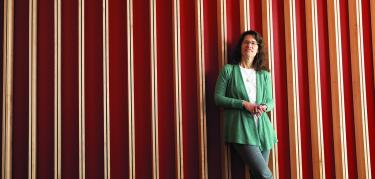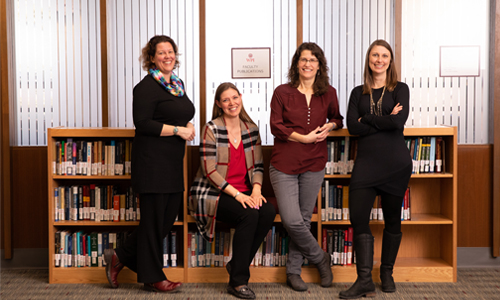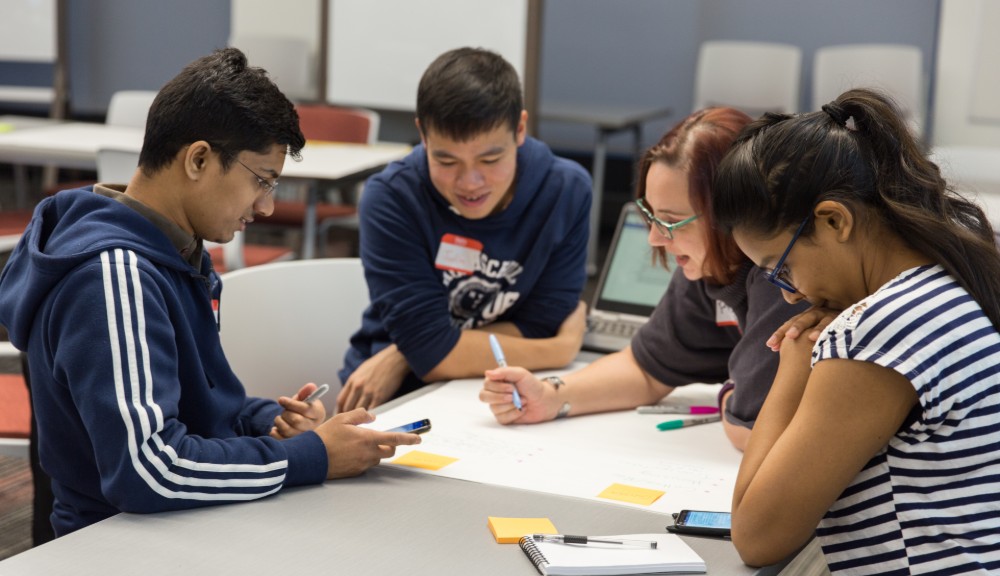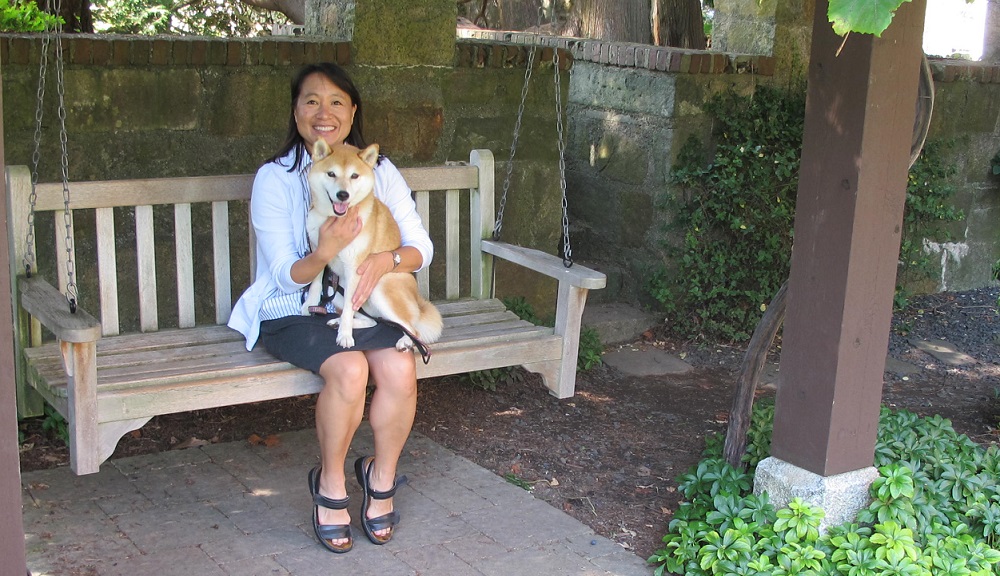A mechanical engineer and materials scientist, Chrysanthe Demetry spent many hours in the lab as an undergraduate, as a PhD candidate at MIT, and as a young faculty member at WPI exploring the properties of materials. But for much of her career, her focus has been a laboratory of a different kind: the classroom.
She is deeply interested in understanding and advancing the intertwined processes of teaching and learning. Whether she is trying out new approaches to engaging students in her own courses or helping other faculty members become better teachers, she takes a scientific approach to her work: hypothesizing, experimenting, synthesizing what she has learned, and then sharing that knowledge broadly.
A Career Crystalizes
Demetry says she cannot remember a time when she was not interested in science. She found support for her budding curiosity at school and at home, particularly from her father, longtime WPI electrical engineering professor Jim Demetry. “When I started doing high school science projects, I got my dad’s help—in a good way!” she says. “He got me access to lab equipment and helped me think through my experiments.”
By the time she enrolled at WPI, her interests had crystalized around materials. “I loved thinking about and measuring the properties of materials,” she says, “and thinking through how different structural features might influence those properties. Of course, I also loved breaking stuff!”
She completed her MQP (Major Qualifying Project) on the processing properties of metal composites and her IQP (Interactive Qualifying Project) at the Washington, D.C., Project Center, where, sponsored by the National Society of Professional Engineers, her team developed recommendations for how the organization could increase understanding of engineering among high school students, teachers, and guidance counselors.
Demetry was accepted as a PhD candidate at MIT, where, as an Office of Naval Research Graduate Fellow, she worked with renowned materials scientist Yet-Ming Chiang on the properties of ultrafine-grained titanium dioxide. Her research earned her a graduate student award from the Materials Research Society.
She also completed a minor in higher education administration at the Harvard Graduate School of Education. “By my college years, I knew I wanted to be a professor,” she says, “and that I was interested not just in teaching and research, but in how institutions are run and led, and how they change.”
With her doctorate in hand, she applied for just one faculty position. “I wanted to teach at WPI because of its institutional values, which encourage close interactions between students and faculty,” she says. “But especially, I was drawn back by the IQP and the opportunity to work with students on projects.”
Demetry made quick and exceptional progress along the tenure track. She won a five-year CAREER Award, the National Science Foundation’s most prestigious honor for young faculty, to advance her work in ceramics. She earned the Norton Professorship, established six years earlier by a Worcester manufacturer with deep historical ties to the Institute. She won the Bradley Stoughton Award for Young Teachers from ASM and WPI’s Board of Trustees’ Award for Outstanding Teaching. (She was named the Carnegie Foundation for the Advancement of Teaching’s Massachusetts Professor of the Year in 2011.)
But amid an intense focus on teaching, research, and service, she also embarked on a journey that would take her deep into some of the most profound questions about education.
Flipping the Classroom
One of the first courses she taught at WPI was Introduction to Materials Science. “I love that course,” she says. “In a way, it’s easy to teach because it’s not hard to get students interested in the fascinating world of material properties.”
Easy or not, Demetry almost immediately began wondering how she could do more to help her students learn. The standard “sage on the stage” model of classroom instruction has changed little in modern times, though a substantial body of research suggests that students learn more and gain greater confidence in their ability to use what they learn if they actively engage with ideas rather than passively absorb them from a lecture.
Starting with that premise, she turned Introduction to Materials Science into the central focus for her growing interest in challenging embedded assumptions about how instructors should teach and how students should learn. Once again, she’d found a venue where she could “break stuff,” only now she could put it back together differently to create a better outcome.
The start of her quest coincided with a campus wide initiative funded by the Davis Educational Foundation aimed at helping faculty introduce active and cooperative learning into their courses. “I started with very simple ways of breaking up lectures with informal collaborative learning activities,” she says, “and I gained confidence in that.” Demetry was also one of the first professors at WPI to use “clickers” to give students a way to answer questions, take polls, and provide feedback in real time.
But her attempts to get students to interact weren’t reaching everyone. “No matter what I did, about a third of the class would not engage with their classmates,” she says. “So I started introducing more structured team projects in class, which required everyone’s participation.”
The structured projects worked, so she next took aim at another component of the standard lecture course: the textbook. “By 2009 I was still using the textbook as the main learning resource,” she says. “I decided, instead, to make my own video lectures so students could more readily engage with the material before coming to class.
“Then, I stopped lecturing in class entirely, which freed up class time for applying the basic knowledge and ideas from the online lectures to interesting conceptual and application problems. These were higher-level and more complicated than what was in the lectures, and they used a strong element of team-based learning. In educational lingo, this is known as a flipped classroom.”
By having students watch a lecture—the traditional heart of a college course—on their own time and completing what would traditionally be homework in class, Demetry says she was able to better track what students were learning and what was causing them to struggle. And students seemed to appreciate the flipped model. “They really valued being able to collaborate with peers and to learn the material together.”
Teaching the Teachers
Demetry’s work in educational innovation has gone well beyond that one course. She’s introduced innovations to WPI’s renowned Global Projects Program, including a framework for cross-national project advising that she developed as co-director of WPI’s Bangkok Project Center (she has advised at nine global centers since 1998), and she recently helped launch and direct WPI’s Grand Challenges Scholars Program. She has also shared what she has learned with colleagues on campus, and more widely through conference presentations and peer-reviewed publications (more than half of her 35 journal articles relate to undergraduate education).
In 2006 she was given an opportunity to magnify her impact on educational innovation at WPI when provost Carol Simpson invited her to become the director of the Center for Educational Development, Technology, and Assessment (CEDTA), which had been without a leader for more than a year. “I had benefitted greatly from the center,” she says, “and was concerned that it might disappear, so I accepted the offer.”
A few years later, WPI trustee Paul S. Morgan, former chairman of Morgan Construction Company and an alumnus of Harvard University, learned about Harvard’s Derek Bok Center for Teaching and Learning, which teaches faculty members how to teach. He was surprised to learn that PhD candidates typically receive no formal training in something that may constitute a major element of their careers. “To his credit and our benefit,” Demetry says, “he was really intrigued by that.”
Learning that WPI had a similar center, Morgan decided to put CETDA on a firmer foundation and give it room to expand its mission by endowing it with a $2.1 million gift. The result was the Morgan Center for Teaching and Learning, which Demetry has led since 2010. Like its predecessor, the Morgan Center is dedicated to helping WPI faculty members become more effective teachers and to encouraging the kind of experimentation and innovation she, herself, has undertaken over the years.
In addition to monthly “Food for Thought” programs, teaching consultations, mentoring programs, and the other services CEDTA had provided, the Morgan endowment enabled the center to offer Teaching Innovation Grants to help faculty pursue creative ideas and to intro.duce faculty learning communities.
“There will always be value in helping individual faculty members,” she says, “but you can have even more impact when you bring faculty together from across several disciplines who are thinking about similar issues in their teaching.”
Each year, faculty members submit potential themes for the next round of learning community grants, sometimes with surprising results. “A recent theme was visual communications,” Demetry says. “This wasn’t on our radar at all, but it turned out there was a lot of faculty interest in it.”
Once the theme is established, faculty members submit proposals. The winners receive funding for their individual projects, but are also assigned to interdisciplinary communities with which they meet regularly to share ideas and experiences. “These are faculty members who hadn’t previously connected with each other, but who are brought together around an area of common interest. While pursuing their own ideas, they also generate institutional knowledge that other faculty members can use.”
In recent years, WPI has provided funding to bring instructional designers to campus, which has enabled Demetry to redirect her energies.
“I’ve been directing faculty more and more to these experts and turning my attention to some more strategic and structural issues,” she says. “An example of that is classroom design—because our classrooms, until recently, have been pretty traditional and woefully out of line with our educational philosophy, in many ways.”
Building on the work of an IQP team, which explored the growing movement toward active learning, and collaborating with WPI’s Academic Technology Center, Demetry helped spearhead WPI’s first dedicated active learning classrooms in the new Foisie Innovation Studio, as well as a redesign of Kinnicutt Hall in Salisbury Labs to better support joint work and discussions.
“We’ll probably always have some classic lecture halls,” she says, “but we’re making progress toward having classrooms that support the technologies and pedagogies that professors really want to use.”
With this new focus, Demetry has added a new dimension to her long quest to explore the science of teaching. Today, she is not just running experiments in the laboratory of the classroom, she is redesigning the laboratory itself. In the process she is emulating what she once said was her chief goal as a teacher and a project advisor: to help her students become lifelong learners. Put another way, she is demonstrating that the best teachers never stop being students.





